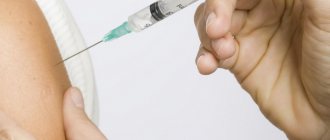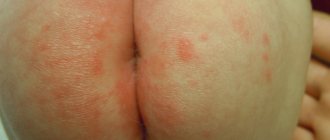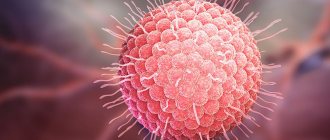Chickenpox in children is the most common disease after ARVI that parents have to deal with. The disease cannot be called dangerous, since most often it occurs in a mild form, and after recovery a stable immunity is formed. Diagnosing the pathology is not difficult, since the signs are clearly expressed.
What is chickenpox, its characteristics in children and adults
Chickenpox is an infectious disease caused by the varicella zoster virus, which belongs to the herpes family of viruses. It is characterized by fever, a rash with various elements (from spots to crusts), severe itching and catarrhal phenomena.
A feature of type 3 herpes virus is its volatility. In a poorly ventilated area, it can spread up to 20 m, and anyone who has not had chickenpox can become infected.
Chickenpox most often occurs in preschool children, but is extremely rare in children under 6 months of age.
In newborns, chickenpox has an extremely severe course. They are often diagnosed with atypical forms of chickenpox.
By age 6, 70% of children have antibodies to chickenpox and are immune for the rest of their lives.
After a person has chickenpox, they develop antibodies to the herpes virus type 3, and an immune response is formed to the re-introduction of the virus. But with immunodeficiency, shingles or a repeated case of chickenpox may develop, since the virus continues to “live” in the nerve ganglia and it is impossible to completely recover.
Shingles most often affects people with immunodeficiency. A peculiarity of this disease is that the rash does not spread over the entire skin, but along the course of the nerve, for example, along the intercostal spaces or on the face along one of the branches of the facial or trigeminal nerve. This disease is unpleasant, its prodromal period is especially unpleasant; often the patient does not associate it with the manifestation of herpes infection.
Chickenpox during pregnancy
If a woman does not have immunity to the chickenpox pathogen at the time of conscious planning of pregnancy, she will be recommended to undergo appropriate vaccination. Infection during pregnancy is dangerous for the fetus until about 20 weeks. At this stage, the virus causes intrauterine death of the fetus, which ends in miscarriage or stillbirth. It is also possible to develop severe defects that lead to disability of the born child.
At later stages, the effect of the virus on the body of both mother and fetus weakens, reaching a second peak immediately before childbirth. Infection with chickenpox in the later stages is fraught with the development of pneumonia, which can also lead to the death of the child. In such cases, special therapy with immunoglobulins and specific antibodies is carried out.
Lack of immunity to chickenpox in general is not an indication for termination of pregnancy.
How does chickenpox manifest in children? Course of the disease
Usually, after contact with a sick person, after 11–21 days (this is the incubation period of chickenpox), the first signs of chickenpox appear in a child. The long incubation period often causes a little confusion among parents.
It would seem that the meeting with the patient was a long time ago, and the threat of getting sick has already passed, and then the child begins to complain of body aches, chills appear, the temperature rises to 38 - 39 ˚C, nasal discharge appears, the baby becomes lethargic and drowsy. Since a lot of time passes after contact with a patient, mothers cannot always understand that these are the first symptoms of chickenpox in children.
After a day or two, a rash appears. It is initially small-spotted or spotted. Children usually complain of itching, and children under four years of age may cry and act restless. Within a day, the spots turn into vesicles filled with serous contents. After a few days, the blisters open, and in their place crusts form on the skin. After the crust comes off, the wound heals completely, leaving no scars.
It should be noted that the rash appears (sprinkles) every 2 - 3 days for 3 - 7 days, therefore all the elements of the rash are different (polymorphic).
The child is contagious two days before the first signs of the disease appear, during the period of rashes and up to seven days from the moment of the last addition.
It should be noted that usually the younger the child’s age, the easier he tolerates the disease. It is easier for a 3-year-old child to survive this period than for an adult.
Symptoms of chickenpox in children
- temperature above 38˚С. Please note that sometimes the temperature rises to 40˚C. This is not a complication of the disease, but only a feature of the reactivity of the immune system of a sick person. However, in some cases the temperature throughout the entire illness can be 37 °C;
- The appearance of the rash varies in stages. Stages of the rash - spot-bubble-appearance of crusts. The rash appears on the child's entire body, except the palms and feet. Chickenpox is also characterized by a rash on the scalp;
- wave-like appearance of the rash, when after the appearance of the rash there is a short-term lull.
Other symptoms of the disease:
- viral conjunctivitis. It usually appears when the herpes virus affects the first branch of the trigeminal nerve. When viral conjunctivitis appears, children may complain of unpleasant sensations in their eyes, they will say that it is unpleasant or painful for them to look at the light, tears flow from their eyes;
- vulvovaginitis in girls;
- stomatitis - the appearance of a rash on the mucous membranes of the mouth. If a rash appears in the child’s mouth, you should contact your doctor for further examination and possible changes in treatment tactics.
How is differential diagnosis carried out?
Chickenpox in its typical course should be differentiated from a disseminated form of herpes, herpes zoster, enterovirus infection and sudden exanthema. In official guidelines you can find a clause stating that chickenpox should be distinguished from smallpox, however, at present, cases of this dangerous infection are casuistry.
Differential diagnosis is carried out on the basis of:
- Epidemiological history. The doctor examines the vaccination card data, determines whether there was possible contact with infectious patients or with an allergen (food, pollen, detergents), and walks down the street without using repellents.
- Visual inspection. The localization and nature of the rash on the skin, damage to the mucous membranes, nails, and lymph nodes are studied.
The erased form of chickenpox should be distinguished from measles, rubella, bacterial impetigo, allergic reactions and even insect bites. The final diagnosis is made based on:
- Anamnesis data.
- Determining how long ago the child was ill and how the disease developed.
- On what day did the rash appear, the stages of its appearance.
It is especially important to carry out differential diagnosis of the disease in persons with immune pathologies, patients with immunosuppression, pregnant women and women planning pregnancy.
To determine an accurate diagnosis, additional research methods are used:
- Isolation of the virus from the liquid of the vesicles (by PCR or propagation in cell culture).
- Determination of antigens to the herpes zoster virus (by direct immunofluorescence in scrapings from the bottom of the vesicle).
- Serological. Determination of antibody titer by ELISA.
It is important to remember that serological diagnostic methods are not recommended by experts to determine the formed immune response after vaccination.
Swimming with chickenpox
Is it possible to bathe a child with chickenpox when he is sick? This question is especially acute.
Opinions on this issue, as always, differ.
There are recommendations that most people agree with:
- You cannot take a bath, that is, lie for a long time and steam your body (to avoid infection of open wounds).
- Do not use a sponge or washcloth. Do not rub the child’s body with anything or anything.
- Be careful with soaps and shower gels. They dry out the skin and can increase irritation.
- It is better if the child takes a shower.
- After a shower, you need to blot the water with a soft towel. Under no circumstances should you rub your body.
- After the skin has dried, the sores should be treated with brilliant green or fucorcin.
Features of caring for children with chickenpox
Children usually bring the infection from kindergarten and often infect their younger brothers and sisters. Chickenpox in children is mild, and the most unpleasant thing is the rash, which is why these children are treated at home.
We will discuss how to treat chickenpox in children a little later, but for now let’s remember how to care for children with chickenpox:
- diet. If a child refuses to eat, do not force it; it is better to eat a little, but more often. Increase the amount of fruits and vegetables in your diet;
- drinking plenty of water. Fruit drinks, compotes, jelly and homemade freshly squeezed juices are recommended. If the child does not want to drink it, offer tea or water;
- it is advisable to limit active games; trying to keep the child in bed is pointless;
- try to explain that the sores cannot be scratched, the child’s nails must be cut short;
- It is advisable to change bed linen every day, the child should sleep separately in his own bed;
- The room in which the child is located must be washed every day and ventilated at least once an hour;
- It is desirable that there are no other children around the sick child, but, alas, this is not always possible.
Possible consequences and complications
The negative consequences of chickenpox in children are rarely diagnosed; most often, dermatological purulent complications occur - abscess, phlegmon, boils, which leave scars. If the disease is severe, the virus affects internal organs and dangerous concomitant diseases develop.
Possible consequences of chickenpox:
- Encephalitis - pathology manifests itself 7–12 days after the onset of the disease, characterized by frequent convulsions, severe headache, and impaired consciousness. In rare cases, idiocy develops.
- Myocarditis - the virus provokes the development of an inflammatory process in the heart muscle, shortness of breath occurs, the pulse rate is disturbed, and the child may complain of chest pain.
- Pneumonia – occurs in infants with neonatal chickenpox; the condition is dangerous and can be fatal.
- Nephritis is an inflammation of the kidneys that develops 10 days after the first signs of pathology appear; the disease goes away on its own and no specific treatment is required.
Since the virus can penetrate all tissues and mucous membranes, the consequences of chickenpox can be blurred vision, damage to the mucous membranes of the eyes, hepatitis, problems with the pancreas and spleen.
To walk or not to walk?
This is another question in caring for a child with chickenpox that worries parents: is it possible to walk with a baby with chickenpox?
During the period when the child is contagious, walks are not recommended. But if the parents are sure that the baby will not have contact with anyone (for example, if you live in a private house), then you can go for a short walk.
We list the important conditions for walking:
- Body temperature should return to normal.
- The last rash was 7 days ago. Otherwise, if you do go for a walk, there should be no other people on the street, especially children or pregnant women.
- If a child has recently had chickenpox, he should not sunbathe or swim in open water.
- The immune system of a child who has recovered from the disease is still weakened, so he is not recommended to have contact with sick children or unwell adults.
Prevention and vaccination
Chickenpox vaccination for children has been done in our country since 2008, but is still not included in the list of mandatory vaccinations, which means that parents must decide for themselves whether or not to vaccinate their baby.
Vaccination is now recommended from the age of two. The vaccination is done once, provided that the child is under 13 years old, and twice for children over 13 and adults who have not yet been sick.
Vaccination is carried out with Varilrix or Okavax vaccines (they are live attenuated vaccines).
Vaccination takes place according to the following scheme:
- "Okavax" - 0.5 ml (one dose) at a time for children over 12 months of age;
- "Varilrix" - 0.5 ml (one dose) twice with an interval of 2 - 2.5 months.
Emergency prophylaxis is carried out with any of the above-mentioned drugs within 96 hours from the moment of contact with a sick person. In our country, such prevention is not common.
After administration of the drug, after 7 days, signs of chickenpox may appear in the child. This is a mild malaise, an increase in temperature to 38 ° C, and a mild rash may appear. All symptoms go away on their own within a few days. There is no need to treat them; they are not a complication of vaccination.
Another method of prevention is isolating sick children. True, this is ineffective, since in children the prodromal period does not always manifest itself clearly, and the child is contagious two days before the appearance of the rash.
Where to contact?
If you feel unwell, have a fever and a rash appears, it is important to consult a specialist as soon as possible. To do this, you need to call a local pediatrician or a private doctor at home, or, if the child’s condition is serious and life-threatening conditions develop, call an ambulance.
Under no circumstances should you self-medicate or give your child any medications, especially antivirals and antibiotics, until examined by a doctor and determined what disease is present. The exceptions are Paracetamol and Ibuprofen at elevated body temperatures.
To simplify the diagnostic process and avoid false diagnoses, doctors do not recommend treating skin rashes with coloring antiseptics. Despite the fact that chickenpox is usually treated with Fukortsin or brilliant green, this cannot be done, since staining the skin green or red makes it difficult to study the morphological elements and difficulties in making a final diagnosis.
Complications of chickenpox
There are always exceptions, but more often they talk about rules. For example, when a pregnant woman who has not previously had chickenpox gets sick, she has a chance of losing her baby, or the baby may be born with chickenpox.
Children under the age of one year suffer from chickenpox extremely hard, and it occurs in them in an atypical form.
Another option is adults and teenagers. They also sometimes have complications, such as viral pneumonia, myocarditis or encephalitis.
Features of the newborn's body
In babies, the body has many characteristics, since it is still actively developing and adapting to new conditions. Chickenpox in newborns is a rare occurrence. Why?
The child’s own immune system is still weak. But all the necessary antibodies that will cope with pathogens of a variety of diseases come to him through mother's milk. It is known that milk has such a protective function for the first six months, and at approximately 6 months the baby’s body begins to independently fight microbes.
Atypical forms of chickenpox
- Rudimentary. The rash is spotty, there are practically no catarrhal symptoms, the disease passes easily.
- Hemorrhagic form. Bubbles in this form are filled not with transparent, but with blood content. The course of the disease is severe, patients experience vomiting with blood, nosebleeds, and possible black stools. On the second day, petechial rashes (small pinpoint hemorrhages in the skin) appear.
- Bullous form. The bubbles in this form merge, forming so-called bullae. They are usually filled with muddy contents.
- Gangrenous form. It has an extremely severe course.
- Generalized form. With this form of the disease, severe intoxication, damage to internal organs, and hyperthermia are observed.
All atypical forms (except rudimentary) are treated in the hospital, often in intensive care units.
Treatment of chickenpox in children
If you see that your child is sick, call a doctor who will prescribe and monitor treatment. Each drug has its own subtleties and features. Incorrect treatment, as well as its complete absence, can lead to complications during the course of the disease.
- If the temperature rises above 38.5 °C, you can give the child an antipyretic drug based on ibuprofen or paracetamol.
- To reduce skin itching, you can use local ointments such as Gerpevir, Acyclovir. It is possible to use Fenistil gel.
- Antihistamines can be used. For example, the drug Diazolin, it is available in tablets.
- To prevent secondary infection of ulcers, use brilliant green or Fukortsin. The application of such preparations also helps to determine the appearance of new bubbles.
- For a sore throat, you can use herbal decoctions and medications approved for the treatment of children of a particular age.
- Antiviral therapy is mandatory. It is prescribed by a doctor.
Dear mothers, I wish you not to be overwhelmed by the tears of your children, but to do this, be very attentive and patient towards them. Chickenpox is just a part of your child's life, and over time, only photos will remain that remind you of the green-spotted period.
If a child or adult shows signs of chickenpox, it is recommended to contact the nearest branch of the Mama Papa Ya network of family clinics.
Unlike a regular local doctor, such a specialist will arrive to the patient faster.
- The doctor has much more time to examine the patient and prescribe treatment.
- Observation over time will help to detect early signs of complications in time and begin their treatment.
- The doctor will give recommendations to all family members on how to avoid infection, paying special attention to elderly and weakened patients.
The Mama Papa Ya clinic offers chickenpox vaccination services for children and adults. To do this, you need to make an appointment with a pediatrician or therapist, who, after an examination, will give a referral to a treatment room. An examination by a doctor and the vaccination itself take little time and are available in numerous branches of a network of clinics located in Moscow and other cities. Medical services are provided at affordable prices.
Reviews
Good clinic, good doctor!
Raisa Vasilievna can clearly and clearly explain what the problem is. If something is wrong, she speaks about everything directly, not in a veiled way, as other doctors sometimes do. I don’t regret that I ended up with her. Anna
I would like to express my gratitude to the staff of the clinic: Mom, Dad, and me. The clinic has a very friendly atmosphere, a very friendly and cheerful team and highly qualified specialists. Thank you very much! I wish your clinic prosperity.
Anonymous user
Today I had a mole removed on my face from dermatologist I.A. Kodareva. The doctor is very neat! Correct! Thanks a lot! Administrator Yulia Borshchevskaya is friendly and accurately fulfills her duties.
Belova E.M.
Today I was treated at the clinic, I was satisfied with the staff, as well as the gynecologist. Everyone treats patients with respect and attention. Many thanks to them and continued prosperity.
Anonymous user
The Mama Papa Ya clinic in Lyubertsy is very good. The team is friendly and responsive. I recommend this clinic to all my friends. Thanks to all doctors and administrators. I wish the clinic prosperity and many adequate clients.
Iratyev V.V.
We visited the “Mama Papa Ya” Clinic with our child. A consultation with a pediatric cardiologist was needed. I liked the clinic. Good service, doctors. There was no queue, everything was the same price.
Evgeniya
I liked the first visit. They examined me carefully, prescribed additional examinations, and gave me good recommendations. I will continue treatment further; I liked the conditions at the clinic.
Christina
The doctor carefully examined my husband, prescribed an ECG and made a preliminary diagnosis. She gave recommendations on our situation and ordered additional examination. No comments so far. Financial agreements have been met.
Marina Petrovna
I really liked the clinic. Helpful staff. I had an appointment with gynecologist E.A. Mikhailova. I was satisfied, there are more such doctors. Thank you!!!
Olga








